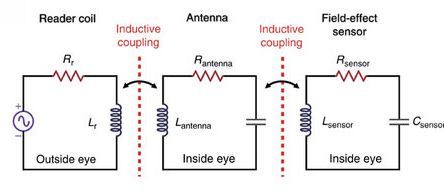By Gary Elinoff, contributing writer
They say that the eyes are the windows to the soul, and while that may be true, the eyes are also the windows to the body. A new wearable contact lens developed at Ulsan University and Kyungpook National University in South Korea is able to stay on the eye indefinitely and yield information continuously that could previously only be obtained sporadically via drawing blood or by direct measurement in a medical office. The team, led by Joohee Kim, Minji Kim, and Mi-Sun Lee, made use of the fact that tears carry some of the same physiological information that blood does.
The challenge and the goal
The device’s substrate must be mountable on a commercial contact lens in order to safely stay in the eye. In order not to interfere with vision, the device’s sensor and communications antenna must be transparent and able to stretch along with a traditionally functioning, blinking eye. Human tears are an excellent surrogate for blood glucose so obtaining the appropriate measurements was one project goal. The other is to affect continuous monitoring of intra-eye pressure to evaluate glaucoma.
Monitoring intraocular pressure
A graphene channel, along with a source and a drain composed of graphene-silver nanowire (Graphene/AgNW) forms a FET, and this FET is the basis of the eye pressure sensor. As the eye’s intraocular presume (IOP) increases, so does pressure on the FET, which changes its electrical characteristics.
The entire system is, in effect, an RLC circuit which picks up magnetic probing signals from an outside probing interrogator. A tiny antenna, also composed of graphene/AG, receives electromagnetic signals from an outside probing device, which powers and also interrogates the FET. The result is then sent back to the outside probing device via the antenna. Thus is pressure measured, as depicted below.

Wearable contact lens senses intraocular pressure. Image Source: Nature (edited).
The structures described above also fulfill the requirements for stretchability and transparency, although the antenna will be somewhat noticeable to the wearer. The device is mountable on a wearable soft contact lens.
Measuring glucose levels
The experiment was conducted on a rabbit, which, three hours after the device was inserted, showed no distress and was behaving normally when measurements were taken.

Measuring glucose levels by analyzing tears. Image Source: Nature (edited).
Implications of the project
Glucose levels and IOP are readily and routinely measured today, but only in one measurement at a time in a medical office. In the future, patients can wear the fully developed contact lens and have a reader/interrogator at home. As often as prescribed, they need only approach the reader/interrogator, and the parameters can be measured and recorded.
Treating physicians, up to this point, have to rely on one-time measurements of these vital parameters, conducted in a stressful clinical environment. It didn’t take the rabbit long to accustom itself to the contact lens, and it shouldn’t take a human, already used to contact lenses, any longer, despite the slight visibility of the antenna. Clinicians will soon have a steady stream of measurements that they can correlate with other factors, such as sugar intake in meals. The result will be better medical data leading to better medical diagnoses.
Advertisement
Learn more about Electronic Products Magazine





